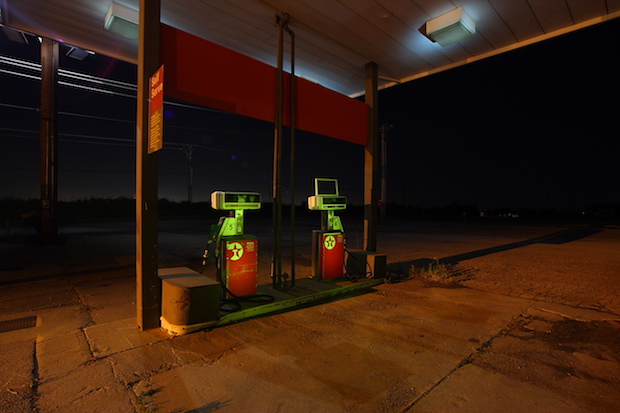
An abandoned gas station near Edmond, Okla.
Michael Kesler / Flickr/CC BY-NC-ND 2.0


An abandoned gas station near Edmond, Okla.
Michael Kesler / Flickr/CC BY-NC-ND 2.0
Oklahoma lawmakers are staring into a budget hole that’s nearly $900 million deep — and they might not be able to cut their way out of it. Legislators are considering tax increases to help fund state government, and one idea is gaining traction: Hiking taxes on gasoline and diesel.
State taxes on motor fuel haven’t been touched since 1987. There are a lot of similarities between the situation then and what Oklahoma lawmakers now face: An economy shaken by low oil prices and dwindling revenue streams to fund state government.
Raising fuel taxes helped the state in the ’80s — and lawmakers might try it again.
Carl Davis, research director at the Institute on Taxation and Economic Policy, says Oklahoma lawmakers have good reason to raise taxes at the pump.
“The state has one of the oldest gas tax rates in the country,” he says. “It’s turning 30 years old, having not budged a single penny in 30 years.”
A state ballot question to raise the gas tax was trounced in 2005. And over the decades, the value of that unchanged tax rate — 16 cents per gallon of gasoline and 13 cents per gallon of diesel — has eroded with inflation. Davis says more fuel-efficient cars and trucks have also taken a bite out of that revenue stream.
“It’s just the math just doesn’t work to levy the same gas tax rate for 30 years. It just loses purchasing power,” he says.
During the 2016 legislative session, when lawmakers were dealing with a bigger budget hole of $1.3 billion, Rep. Earl Sears, R-Bartlesville, introduced legislation increasing gasoline and diesel taxes by three cents per gallon.
“Once again the same conversations are taking place,” says Sears, chair of the House finance committee. “What are we going to do to fill the hole?”
The 2016 measure was defeated in committee on a 14 to 9 vote. Sears’ three-cent hike on fuel would only have applied when fuel was selling for less than $3 a gallon. Any hike on fuel taxes will likely include such a trigger. Sears expects such legislation to be introduced in the upcoming 2017 legislative session, which starts in February.
“I’ve been told yesterday there’s already a couple of bills,” he says. “I am confident there will be a conversation about raising the gasoline tax.”
Motor fuel taxes are a relatively small revenue stream for Oklahoma, generating about $474 million in 2016, state tax commission data show. That number includes revenue from taxes on other fuels, including compressed and liquified natural gas and aviation for fuels — a drop in the bucket compared to the $4.1 billion and $2.5 billion in income and sales tax revenues.
A Senate report suggested Sears’ bill last year would have only generated an additional $42 million a year. Many of the one-time budget fixes were used to fill last year’s budget hole. So state finance leaders say the math of filling the 2017 hole might have to come from adding up several small increases —like the cigarette tax or ending sales tax exemptions on services like car washes.
The lion’s share of gasoline and diesel taxes in Oklahoma and other states are directed to transportation — agencies and programs that build and maintain highways, roads and bridges. Sears says he’ll push to ensure that revenue from any increase on fuel taxes in Oklahoma remains earmarked for transportation.
Motor fuel taxes almost exclusively support transportation infrastructure. Davis with ITEP says that’s a major reason why politicians — even in red states like Oklahoma — don’t always mind raising them.
“There’s really no such thing as a Republican pothole or a Democratic bridge,” he says. “It’s an issue that brings the parties together.”
“A lot of stars have to align” for motor fuel tax increases to survive state legislatures, Davis says, but there is good evidence to suggest 2017 could see a wave of such tax hikes. Oklahoma is one of about a dozen states seriously considering increases, a list that includes Republican strongholds like Mississippi, Louisiana and Alaska, where Gov. Bill Walker has proposed tripling taxes on motor fuel.
Motor fuel taxes are paid by users, which, “in conservative circles,” Davis says, “can be an especially appealing aspect of it.”
Motor fuel taxes are regressive: They affect low-income people more than those with higher incomes. But, in recent years, gasoline and diesel prices have been pretty low. And, unlike other taxes, Davis says motor fuel taxes don’t usually get the same pushback from the business community.
“At some point it’s just not worth refusing to pay a few more pennies per gallon if the cost is going to be having to hit a pothole and get your vehicle realigned or wasting time and money stuck in traffic,” he says.
The State Chamber of Oklahoma, for example, supports raising motor fuel taxes as long as the increase funds transportation infrastructure, says Mike Jackson, senior vice president of political affairs and advocacy.
“We have always maintained that the tax must be dedicated to the sole purpose of the preserving and improving our roads and bridges,” he wrote in a statement emailed to StateImpact.
Any tax increase proposed by Oklahoma lawmakers will need a legislative supermajority — a tall order, even with a $900 million budget gap. There’s another reason why a motor fuel tax hikes might fly in 2017: It’s not an election year.